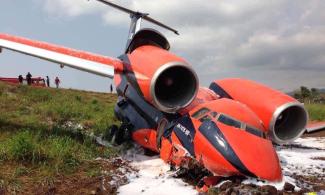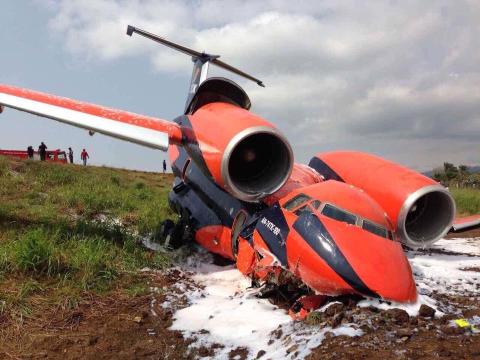
“Due to the presence of birds on the runway, the take-off was rejected at a speed above decision speed V1, which was inconsistent with CAVOK’s Standard Operating Procedures (SOP)," the report read.

The Nigerian Accident Investigation Bureau (AIB) has disclosed in its accident report of the July 29, 2017 aircraft crash at the Sao Tome International Airport that the presence of birds on the runway was the causal factor of the crash.
The bureau also identified failure of the crew to deploy interceptors (speed brakes/spoilers), inadequate flight crew training on details of rejected take-off procedure scenarios, omission of the take-off briefing in CAVOK’s Normal Operations checklist and poor Crew Resource Management (CRM), especially in a multi-crew flight operation as some of the contributory factors to the accident.
A statement by Olayinka Olakangudu, AIB Public Affairs Officer, noted that the aircraft, an Antonov Model AN-74 TK-100, registered UR-CKC, owned by SWIFT SOLUTION FZC, operated by CAVOK Airlines LLC had overrun runway 29 during a rejected take-off at the airport.
The report stated that the captain, the first officer, the flight engineer and two maintenance engineers on board were rescued unhurt except the flight navigator who sustained an injury to his left foot and some minor bruises.
The report explained that the intended non-scheduled return flight to Accra was initiated in accordance with appropriate regulations, adding that visual meteorological conditions prevailed, and an instrument flight rules flight plan was filed by the pilot before the crash.
The report read: “Due to the presence of birds on the runway, the take-off was rejected at a speed above decision speed V1, which was inconsistent with CAVOK’s Standard Operating Procedures (SOP).”
AIB also made safety recommendations to the Instituto Nacional de Aviacao Civil (National Civil Aviation Authority of STP), calling on it to improve the habitat management programme, including reduction or elimination of trees, shrubs and other plants which provide food, shelter or roosting sites for birds.
The body was also advised to enhance its aerodrome grass management appropriate to the prevalent species and the degree of risk that they pose, adding that it should also liaise with local inhabitants to limit the attraction of birds to fields in the vicinity of the airport.
AIB also said the authorities “should install specialized ground-based radar equipment used for tactical detection of large flocking birds. Should adopt and extend Runway End Safety Area to conform to ICAO standards. Should include the information about the ravine at the end of RWY 29 into the AIP and Send it as Notice To Airmen (NOTAM).”
To the Ukraine Civil Aviation Authority, AIB recommended that it should enhance its oversight functions by reviewing all safety related items pertinent to operators’ checklists and manuals, while CAVOK Airlines was recommended to review its Rejected Take Off (RTO) training syllabus to incorporate robust RTO training plan for both initial and recurrent aircraft type simulator training and assessment to include unexpected scenarios and stop-and-go decision making.
The Ukrainian body was also advised to review its Normal Operations (NO) checklist in order to include take-off briefing as an item for each flight.
It is the first time AIB would be would be invited by other country to investigate accident in its domain.
The Commissioner, AIB, Engineer Akin Olateru, said the investigation was able to be carried out as a result of effective collaboration and corporation the bureau had garnered in the last 24 months with aviation stakeholders.
The Banjul Accord Group Accident Investigation Agency (BAGAIA) had invited AIB Nigeria to conduct an investigation into the crash, which by the International Civil Aviation Organization (ICAO) Annex 13 was the responsibility of the state of occurrence.